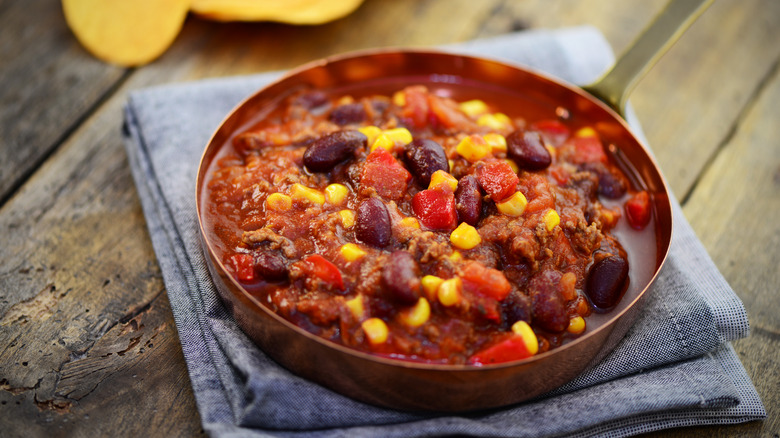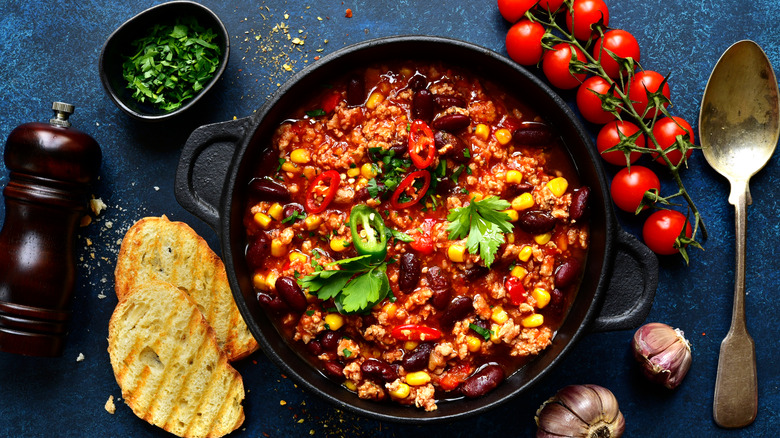The Origins Of Chili Are Steeped In Myth And Legend
Sometimes, a dish has a specific origin story that people can reference for a fun anecdote to share at dinner parties. However, some dishes have no clear beginnings, while others possess several contradictory backstories. Chili is one such food steeped in a history of multiple hazy rumors.
To be clear, we're talking about chili, the Tex-Mex stew, not the spicy pepper — although the spicy pepper is one of its main ingredients. On the subject of chili's etymology, the word chili comes from the Aztec language, which references the pepper itself. Regardless, it's not out of the question — as Wonderopolis notes — that humanity has likely been mixing meat and peppers for thousands of years now. But where and when was chili invented? We only need to look a couple of centuries into the American past for the modern combination of meat, spices, and vegetable components like beans and noodles.
Competing claims complicate chili's creation
Part of the reason chili's history is unclear is that it was cooked up in the American melting pot. That doesn't mean the United States lays sole claim to it, though. The consensus is chili has multicultural inspirations, even if the specific cultures involved have been debated.
For example, sources like Wonderopolis and Goshen News mention the dubious legend of a Spanish nun, Sister Mary of Agreda. It claims she supernaturally visited Native Americans (which is suspiciously vague; indigenous peoples aren't a monolith). From them, she supposedly learned a chili recipe consisting of onion, pepper, tomato, and venison, then assumedly spread that knowledge throughout Western civilization.
A more believable myth purports immigrants hailing from the Canary Islands (a Spanish archipelago located near Africa) brought the recipe for chili to San Antonio near the start of the 18th century. That emigration is a fact, and colonizers were known to eat chili on the frontier around that time. So, this claim isn't outlandish.
The backstory with perhaps the most credence is that Chili Queens, as reported by KSAT, popularized chili in 19th-century San Antonio. For a hundred years, these women sold the dish downtown, gathering crowds while they cooked their food in kettles over open flames. This is all well-documented, so we can at least conclude these women were instrumental in chili's rise to fame. No matter what, though, it seems clear that Spanish and American cultures were both key ingredients in this recipe.
The modern identity of chili
Chili's heritage is a bit ambiguous, but it's firmly entrenched in American culture today. There are now several different regional chili styles throughout the United States. For example, per the Goshen News, Greek and Macedonian immigrants in 20th-century Ohio created what's now referred to as Cincinnati Chili, a combination of Greek stew, Mediterranean spices, and Italian spaghetti. In the present day, you might even find ingredients like cinnamon, cocoa, or Worchester sauce in this chili variation.
Nevertheless, the most well-known form of chili is the Tex-Mex version. According to State Symbols USA, the Lone Star State even went so far as to enshrine chili as its official state dish in 1977. Furthermore, it claimed that "the only real 'bowl of red' is that prepared by Texans."
The stew is representative of Texas and Tex-Mex food in general, as noted by History. Tex-Mex cuisine (different from Mexican food) owes much of its popularity to the Chili Queens of San Antonio. The San Antonio Chili Stand at the 1893 World's Fair in Chicago also helped. Given chili's cultural significance, it's not hard to see why so many wish to claim its creation for themselves.


